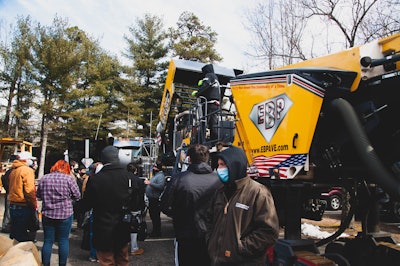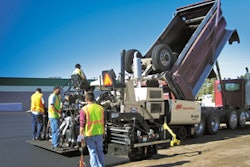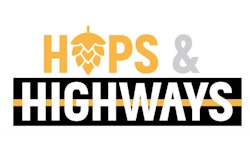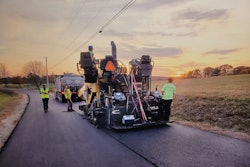
In 2011, only 13% of construction business owners reported cost and availability of labor as a significant problem. Fast forward to 2020 and the share increased to 85%. That means in any given month, there is a shortage of 200,000 to 300,000 workers. This labor shortage has far-reaching implications for worker safety and construction quality—which could adversely impact the entire industry if investments are not made to address the issue.
Thankfully, trade schools all over the country are stepping up and creating programs to help fill the pipeline with workers. Ocean County Vocational Technical School (OCVTS) recently launched the Heavy Equipment Operators Program (HEOP) at their school, becoming just the second program in the state of New Jersey to help make careers in the construction industry a priority.
"Over the past few years it is no secret that more and more youth have been steered toward college. Less students are exposed to the opportunities available for career entry and advancement through traditionally “blue collar”/trade related occupations. There is an opportunity for students to earn and learn and vocational technical schools can help facilitate that process by providing the foundation for employment and serve as a catalyst to advance in their career by developing programing in consultation with industry that will allow students to continue to return and upskill/advance in the career," Gary MacDonald, OCVTS’ director of curriculum and grants says. "These occupations are essential for local economic development, often offer pathways to advanced training (such as apprenticeships), and support an individual’s professional growth if they chose to advance in the trade. Skilled employees have the opportunity to earn a good income and those who are truly ambitious can use those skills to advance in an organization or establish their own business."
Launched in 2020, the OCVTS's HEOP has 31 students who are enrolled on a “shared-time” basis in the first year of the program. This means that they spend half of their school day in a local comprehensive high school and attend OCVTS, usually beginning in 11th grade, for the trade related technical instruction for the other half of their day. The total length of the program is two years or 900 hours. OCVTS is expecting all 31 to return for the second year and enrolling another cohort of first year students. The total enrollment of the program could potentially double next year.
Attracting Students & Creating the Curriculum
The OCVTS is very involved with business, industry and their related associations. Through their advisory meetings with local companies the school learned of an emerging demand to find skilled labor in the heavy equipment operator industry. The demand for this program was driven locally by an aging workforce and an increase in construction and development in the region. But they had to get the students interested first.
"It was very important for us to seek industry involvement from the onset of the program's concept," MacDonald says. "Companies such as Eosso Brothers Paving, Earle Asphalt Company, Terminal Construction Corporation, and Esposito Construction have played an important role as advisors in developing the program and recruiting potential students for the program. Industry associations host career fairs and events throughout the region, companies often participate to explain the opportunities available, and OCVTS representatives attend to explain the training programs available that can help put the students on that career path.
"At OCVTS, our Student Services department has a strong relationship with the guidance counselors in local high schools. We routinely host professional development sessions to update them on the career training programs available to the students in the region,” MacDonald continues. “Our industry partners have participated in those meetings and fill a critical role as the potential employer. They are able to answer questions about the local employment opportunities, earning potential and opportunities for advancement in the career. In that sense, they are able to provide input on the skills needed for students to seamlessly transition into their respective companies."
Once they knew they had industry support and student buy-in, OCVTS went about implementing the curriculum. OCVTS is using the National Center for Construction Education & Research curriculum which is a nationally recognized program that the school adapted to their needs. The program allows students to be certified and be recognized as being at the same skill level as others who have taken this program across the country.
"We wanted to build a program that aligns not only with preparing high school students to enter the field, but we also wanted to put them on a path towards apprenticeship because we also offer technical instruction for apprenticeships at the vocational school for adults," MacDonald says.
The program is broken down into modules where the first year of work focuses a lot on safety and basic identification of the equipment. At level two you get into more of the science of the actual heavy equipment, how they run, how they operate, the techniques, etc. OCVTS also uses simulators in their classroom to help teach their students how to operate these machines in a no-risk environment.
Karen Homiek, superintendent of OCVTS, explains the significance of partnering with industry.
“When we were looking at a Heavy Equipment Operator Program as a possibility we connected with Earle Asphalt Company at the same time. Michael Earle shared with us his concerns for an aging workforce and the lack of new men and women entering the industry. He felt that the loss of knowledge that would take place if there were no opportunities for veteran operators to transfer that knowledge to the new workforce would be a loss to the trade. Fortunately for us, he was committed to attracting new people into the heavy construction industry. His organization made a financial donation that allowed us to leverage philanthropic support and Perkins grant funding to acquire the simulators that are the foundation for skills’ development in this program."
And the simulators have been vital to the program and student understanding.
"These simulators were donated by our partners and act just like the real equipment," Joe Moore, HEOP instructor adds. "It's the greatest way for someone to gain experience in a safe way. Equipment so expensive and mistakes out there could be fatal with that piece of heavy equipment. The simulators tell you when you do something wrong or if you created an error and that you need to make corrections."
OCVTS has a simulator for a backhoe, skidsteer, forklift, excavator and more. Students finish tasks on each simulator which will show them their skill level so they know what level they should be at before they could operate a heavy piece of equipment. Students will spend 120 hours operating the simulator.
Providing Real-World Experience
While simulators are great for beginners, operators know that to really learn how to run a piece of machinery, you have to get your hands on them. This is where partner companies like Eosso Brothers Paving come in.
"In 2020, my brothers and I were discussing Eosso Brothers growth strategy. We discussed that our current team is dedicated and loyal, but we are aging and it is taking toll on our crews," Tom Eosso, CEO of Eosso Brothers Paving says. "Our leadership team was discussing a lack of young men and woman in our industry, we created a video to focus on vocational students and high school students not looking to go to college. We feel passionate about our industry and feel that without the younger generation the trades will have a hard time."
Eosso Brothers Paving donated two machines to the program; a skid steer and a 10-ton asphalt roller, both machines in need of some work. The vocational school also has an auto mechanic shop where they will get training by repairing these two pieces of equipment, they also have a paint department which will repaint them. But Eosso Brother's didn't stop there.
The company worked with Moore and MacDonald at OCVTS to orchestrate and equipment demonstration day at the school. The company transported over 10 pieces of heavy equipment for our students to explore and interact with that day which took over an entire acre of the parking facility at the Jackson location. Included in this massive display were an excavator, backhoe, dozer, dump truck, milling machine, paver, roller and a road grader. Students were treated to a full orientation to these sophisticated machines- then had the opportunity to interact with them under the guidance of Eosso Brothers’ Team of skilled operators.
At the end of the day, the students, the OCVTS staff and the Eosso Brothers team were energized with opportunities for these students.
"The whole exhibition surpassed my expectations," Moore says. "The HEOP students enthusiasm reflected their appreciation of today's presentation. I spend many hours in the classroom teaching from textbooks, lecturing, and showing videos describing the various types of heavy equipment. Additionally explaining the maintenance and safety skills expected of heavy equipment operators. The demonstration presented by Eosso Brothers covered all the topics and more in a few hours. This experience helped students to envision their future's as heavy equipment operators. The students hands-on introduction to the different types of equipment and operation and interactions with Eosso employees was an invaluable source of learning."
The Future of the Industry Needs Support
Programs like these don't happen without industry support however.
"Every contractor is struggling with hiring and getting new employees, all you hear is the young generation are lazy, they don’t want to work," Eosso says. "This HEOP program will give the younger generation a vision to the future in the construction industry. Companies are in need of young talent and are trying to attract new employees. This program will help all companies and any way they can donate or assist the HEOP program with equipment or training will only benefit the industry."
It took a collaborative effort to get the program off the ground and to get students engaged.
"The key to the success of these type of programs is the relationship between the industry and the educational partner," MacDonald says. "We just so happened to gain a tremendous amount of support from the industry right off the onset, as soon as we went out to start talking to people like Tom Eosso and Micheal Earle, they just jumped right on board to support the program's development. The industry and education came together to inform parents, students and guidance counselors on the opportunities that are available in this industry and how you get there.
"You have the industry people saying, 'this is your earning potential or the career ladder you can you can go through' and you have OCVTS saying 'here's the education that you get to get there.' That leads to people realizing that there are relevant, real world opportunities available now to students who want to take advantage of it. We started several programs recently, but none of them have seen the growth or the start the way that this program did. And I think that it was attributed to how much the industry came together with us on this."
If you're a construction business owner struggling in your area to find the workers you need, consider reaching out to your local technical school.
"I would imagine that there's a lot of companies out there, that if somehow they were able to connect with their counterparts to us in their region, they could probably pull a program like this together," MacDonald adds. "The key is really getting everybody on board. As an educator I believe that it is really important to encourage students to pursue a path whether it's directly to college or directly to work that is best for them. Neither path is finite. Both paths should focus on a career as an outcome. No matter what…in order to advance…you need to continuously learn, adapt, demonstrate resilience, communicate and be a team player."
And it's important to start the conversations with these students, their parents and guidance counselors at every age.
"My brothers and I feel we were fortunate to have had the opportunity to learn at a young age. The young generation does not have the opportunity to learn so when a young person starts in the construction industry, they start as a laborer and shovel. This is where we are losing the kids," Eosso says. "They want to operate but don’t get the chance and they give up and get out of the industry. With these programs, students will have an opportunity like me and my brothers had to learn to operate at a young age and to build successful and rewarding careers around these skills."




















